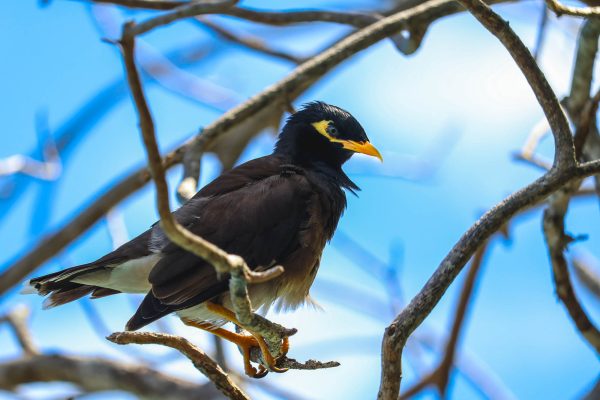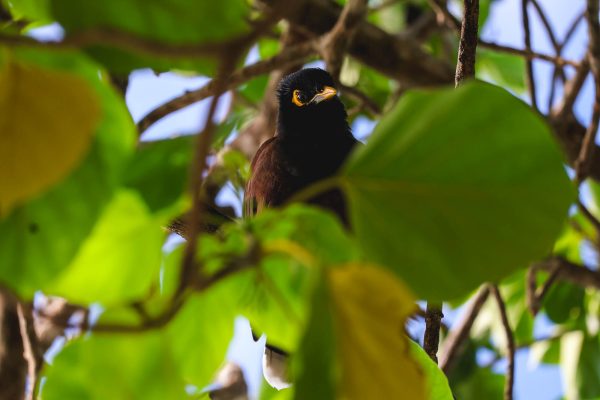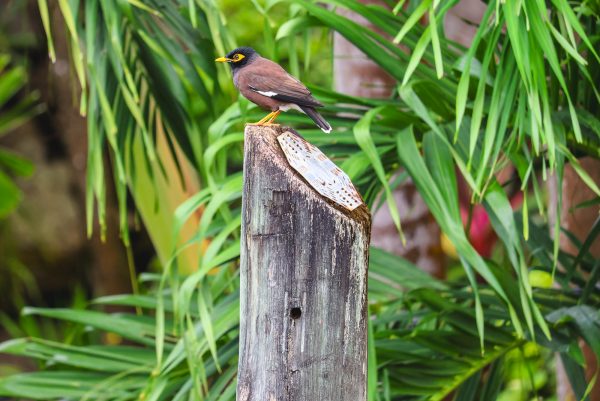Top attractions:
About Common Myna
With a glossy coat of chocolate brown and distinctive patches of yellow behind the eyes, Common Myna (Acridotheres tristis) is a bird that often captures attention wherever it goes. Originating from the South Asian region, this bird, characterized by its robust build and agile movements, has successfully spread its wings to various parts of the world.
A member of the starling family, Sturnidae, Common Myna shares its lineage with birds like starlings and other mynas. However, the distinguishing patches of bright yellow around its eyes and legs set Common Myna apart.
Spotting a Common Myna isn’t much of a challenge for bird enthusiasts. Their fondness for human habitats, such as parks, gardens, and urban streets, makes them easily observable. It is even easier to hear these melodious birds than to spot them. As starlings, Common Mynas seem to have a language with a very wide range of sounds. Historically, this delightful voice resulted in an unfortunate fate for some individuals. For example, the Mughal emperor Babur in the 16th century, noted the Common Myna’s ability to imitate human speech, making it a favorite choice for captivity and amusement in royal courts.

This Common Myna wants to be a writer. Photo by Alis Monte [CC BY-SA 4.0], via Connecting the Dots
Interestingly, while they have been applauded for their vocal abilities and adaptability, their relationship with humans is multifaceted. On one hand, they play a crucial role in the ecosystem by consuming various pests. On the other, in places where they’ve been introduced, they are often considered to be pests themselves.
Common Myna Details
- Size: Length 23-26 cm / 9-10.2 in, wingspan 40-43 cm / 15.7-16.9 in
- Mass: 85-143 g / 0.19-0.31 lb
- Color: Chocolate brown body, a black hooded head, a bright yellow patch behind the eyes, yellow eye-ring, and legs. The wings have white wing patches which are visible during flight.
- Diet: Omnivorous
- Distribution: South Asia (Original)
- Natural habitat: Open woodland, grasslands, urban areas, parks, and gardens.
- Family: Sturnidae
- Closest relatives: Bank Myna and Jungle Myna
- Conservation status: “Least Concern” by the IUCN
- Oldest fossils date: Starlings and mynas as a group have some fossils dating back to the Miocene epoch.


Physical Characteristics
Common Myna is characterized by its glossy chocolate-brown feathers, a black hooded head, and those pop-of-color yellow patches right behind its eyes, this bird doesn’t just blend into the background – it stands out. It struts confidently on the ground, and if you’re lucky, you might even catch it mid-flight, white wing patches flashing and tail showing off its elegant white tip.
But what really catches most folks’ attention is the bright yellow. From the eye patches, the yellow extends into a brilliant eye-ring, making its brown eyes seem even more inquisitive. That sharp bill? Perfectly yellow, and it’s not just for show either. It’s versatile, allowing our little feathered friend to snack on fruits, munch on seeds, or nab unsuspecting insects.

If you’re trying to figure out if the Myna you’re observing is male or female, well, good luck! They’re pretty similar in appearance, both flaunting the same dashing colors. But here’s a tiny hint: when they burst into song or call out, the males tend to be the louder, more show-offy ones. Nature’s own version of a rockstar, if you ask me!
Habitat & Distribution
Imagine taking a stroll in both bustling city streets and serene countryside lanes and bumping into the same bird – that’s Common Myna for you! They’re quite the travelers, having expanded their stay from their native South Asia to swanky spots in the Middle East, paradise beaches of Mahe, Seychelles or Mauritius, and even vacationing Down Under in Australia and some parts of the U.S. Whether it’s open woodlands or urban coffee shops, these adaptable birds make themselves right at home. In other words, if Common Myna inhabits the area, you’ll be able to spot them despite the terrain.

Common Myna is not shy of showering in a pool either. Photo by Alis Monte [CC BY-SA 4.0], via Connecting the Dots
Diet & Feeding Behavior
Ever watched someone at a buffet, filling their plate with a bit of everything? That’s Common Myna at nature’s grand feast! They’re not the picky eaters of the bird world; in fact, they’re refreshingly omnivorous. From juicy fruits and crunchy seeds to those creepy crawlies, Myna’s diet is as varied as your playlist. And if they find themselves in urban settings, don’t be surprised to see them sneaking a fry or two from unattended plates.
Their feeding style is a blend of curiosity and opportunity. Picture this: a Myna, hopping confidently on the ground, head tilting side to side, eyeing every little movement. And in a flash, they snap up an insect, looking mighty pleased with their catch. But if they’re in the mood for something sweet, they’re just as adept at plucking a ripe fruit off a tree.
But here’s where it gets interesting. These birds are clever! They’ve been observed dropping hard-shelled snails onto roads and waiting for passing cars to crack them open. Talk about using the resources available! So, the next time you see a Common Myna, remember you’re not just looking at a bird; you’re observing a tiny, feathered strategist. Their intelligence is probably a result of their diet. Being a jack of all trades led these birds to evolve higher problem-solving skills in order to survive, instead of focusing on a certain feeding niche. Many scientists believe that human ancestors chose the same creative feeding strategy as Mynas, making the Homo genus smarter than any of our distant cousins with whom we competed about million years ago.
Breeding & Nesting Habits
These birds don’t just find a partner for a season; they’re in it for the long haul. Yep, Common Myna believes in monogamy. Once they’ve wooed a partner with their distinct calls and impressive flight displays, they stick together. It’s a feathery love story that often lasts a lifetime!

Couple of Mynas interacting on a beach in Seychelles. Photo by Alis Monte [CC BY-SA 4.0], via Connecting the Dots
Nest-building or displacing native birds is another area where Common Myna displays its adaptability. These crafty birds aren’t too fussed about location. You might find them setting up home in a hole in a tree, a comfy spot in your attic, or even in that little space in your roof gutter. They’re resourceful architects, using twigs, leaves, and whatever else they can find to craft a snug little home for their eggs.
Speaking of eggs, Mama Myna usually lays a clutch of 4 to 6 glossy, pale blue or greenish beauties. Both parents take turns keeping them warm, and in about a couple of weeks, the eggs hatch into hungry chicks. For the next few weeks, the dedicated parent-duo is in full action, feeding and protecting their brood until they’re ready to spread their wings and fly. So, if you ever spot a couple of Common Mynas fussing about, remember, that they might just be two parents, busy with the joys and challenges of raising their young!


Conservation Status & Threats
Now, let’s get a bit serious for a moment. Common Myna might seem like it’s everywhere, having a ball, thriving in diverse environments, and generally living the bird version of ‘the good life’. However, life isn’t entirely a song for these feathery fellows. While they’re currently listed as “Least Concern” on the IUCN Red List, they face their share of challenges.
In some regions, these birds are trapped and traded, both as pets and, sadly, as bait in bird-fighting. Urbanization and habitat loss are additional pressures they face. It’s a complex issue: On one hand, they’re champions of adaptability, thriving in urban spaces. But on the other, they face threats from the very habitats they’ve become part of. So, as we admire Common Myna for its charm and resilience, it’s essential to remember that every species, no matter how widespread, has its vulnerabilities.

Conclusion
As we reach the end of our feathery tale, it’s clear that Common Myna is no ordinary bird. Their striking appearance, adaptability, and intelligence make them stand out in the avian world. From their omnivorous diet to their clever tactics to get a meal, and from their enduring love stories to their versatile nesting habits, they truly are nature’s marvels.
However, as is often the case in nature, with great adaptability comes great responsibility. The Myna’s success in spreading its wings across continents highlights the delicate balance of ecosystems. While they thrive and flourish, their expansion can sometimes challenge other species struggling to maintain their foothold.
For us, as admirers and custodians of nature, it’s a reminder of the intricate web of life. Every species, no matter how common or widespread, plays a pivotal role in the grand orchestra of nature. Our part? To appreciate, understand, and ensure that every note, every chirp, and every song continues to echo, creating a harmonious world for all.